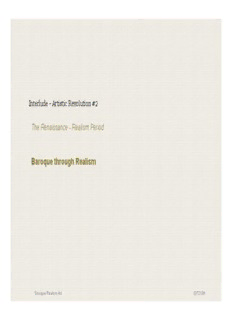
Baroque through Realism PDF
Preview Baroque through Realism
Interlude - Artistic Revolution #2 The Renaissance - Realism Period Baroque through Realism Baroque-Realism Art ISP213H many -isms The pattern goes: • Baroque - 17C • Rococo - 18C • Neo-Classicism - 18C-19C • Romanticism - 19C • Pre-Raphaelites - 19C The tendency is toward increasing realism, with side trips into Romanticism and the cul-de-sac of Rococo... Baroque-Realism Art ISP213H Principia de Revolutionabis La geométrie Optiks Mémoirs Opus maius Astronomia nova Principia (Ampere’s law) 1400 1600 1800 2000 Baroque Dialogue concerning two world systems Researches in electricity Discourses on two new sciences Like Mannerism, Baroque was originally a pejorative • “grotesque”, “distorted”, “absurd” used to describe the deviation from Classical style in architecture of the early 18C The counter reformation was basically over • The Catholic Church had regained strength and an unhappy balance was established with Protestantism but, as we’ve seen, warfare during the 17C was essentially constant • And, in this turbulence, Physics was essentially born – The complexity of nature was organized into a coherent whole – Representation, for the first time, truly implied insight as to how Nature Is – Method centered around experiment, demonstration and System-it was public Truth became an explicit scientific goal Painting shed the neo Platonic religiosity and authority that dominated the Renaissance – At once simple and direct to the eye–yet with incredibly complex technique – Art, and all of society was influenced by the science Truth became an explicit artistic goal. While the Baroque was a truly international style, as was the Rococo to follow, the most influential father of the style was an Italian: the incorrigible Caravaggio. Baroque-Realism Art ISP213H Michelangelo Merisi aka Caravaggio (1572-1610) Polite society had not before seen many like him • He was on a mission to discover truth Dismissing traditional technique, he painted oil directly to the canvas from live models Propriety was not a word to describe him - many of his commissions were rejected by patrons for their lack of decorum in religious subjects Nothing, and yet everything was sacred to him These are not Greek Gods! He attempts to consciously destroy the previously consistent Classical images He has unmasked the imaginary Classical image and shown it for what it is. This is a direct attack on polite art - he’s about showing things as they are, “truth” is what he demands of himself. We’re in a new era of artistic individualism. Caravaggio, Sick Bacchus, 1593, Borghese, Caravaggio, Bacchus, 1596, Uffizi, Florence Rome Baroque-Realism Art ISP213H Light is what Caravaggio commands Notice that Solome and her mother both have two heads coming from the same body? This business with detached heads figures into a dozen of Caravaggio’s paintings in one way or another Caravaggio, Solome with the Head of the Baptist, 1609, Madrid Baroque-Realism Art ISP213H remember this Baroque-Realism Art Caravaggio, The Taking of Christ, 1598, Odessa ISP213H a scandal At once, this seems a well-put together piece balanced in color, top to bottom. Superb lighting, enhancing the drama. But, Caravaggio’s use of a drowned girl as the model scandalized Rome. Caravaggio, Death of the Virgin, 1606, Louvre, Paris Baroque-Realism Art ISP213H perhaps his masterpiece Notice the mere hint of the halo, otherwise Christ is a regular person. The pointing is a quotation from Michelangelo’s Creation of Adam. The light follows the gesture, falling directly on the subject of Jesus’ intentions. Caravaggio, The Calling of Saint Mathew, 1599, Rome Baroque-Realism Art ISP213H how many ways can you say you’re sorry? “The details of the first Roman years are unknown, but after the time of the Contarelli project Caravaggio had many encounters with the law. In 1600 he was accused of blows by a fellow painter, and the following year he wounded a soldier. In 1603 he was imprisoned on the complaint of another painter and released only through the intercession of the French ambassador. In April 1604 he was accused of throwing a plate of artichokes in the face of a waiter, and in October he was arrested for throwing stones at the Roman Guards. In May 1605 he was seized for misuse of arms, and on July 29 he had to flee Rome for a time because he had wounded a man in defense of his mistress. Within a year, on May 29, 1606, again in Rome, during a furious brawl over a disputed score in a game of tennis, Caravaggio killed one Ranuccio Tomassoni.” http://gallery.euroweb.hu/bio/c/caravagg/biograph.html This led to flight to Naples and Malta, continued working. But only a Papal pardon could relieve him of his anxiety at being a fugitive. So, he painted an apology, offering up his head as evidence of his penitence. A pardon didn’t come. Caravaggio, David, 1609, Borghese, Rome. Baroque-Realism Art ISP213H Caravaggio’s influence was direct Especially to the epitome of the 17C realistic painters: Rembrandt van Rijn (1606-1669) - the master of portraits Rembrandt, Self-Portrait, 1627, Kassel Rembrandt, Self-Portrait, 1669, Hague, Netherlands. Rembrandt, Portrait of Nicolaes Ruts, 1631, Frick, NY. Baroque-Realism Art ISP213H
Description: